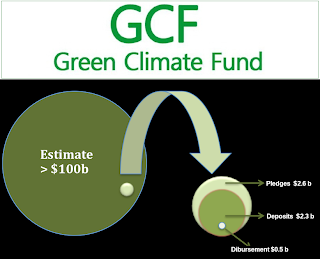Although there are detractors, the Green Climate Fund (GCF) is an important cornerstone of a global climate agreement. Combating climate change is a global effort, however, less developed countries commonly have less resources to do so even though they are the hardest hit. The GCF is a UNFCCC founded mechanism to transfer money from the developed to the developing world, in order to assist the developing countries in adaptation and mitigation practices to counter climate change.
The logic behind the GFC is simple, if we are to ask less developed nations to contribute to climate solutions that they did not create, those nations that are responsible for anthropogenic warming must assume some of the cost.
In the last four years the United Nations (UN) and others have been working on raising $100 billion in capital by 2020 from member nations and the private sector (it should be noted that this is a very tiny percentage of the $70 trillion global GDP). The money will be used by the GCF as the primary multilateral vehicle for climate change finance. Its guiding mission to channel investment capital from developed to developing nations for the purposes of climate change mitigation, adaptation and sustainable development.
The UN backed Green Climate Fund becomes operational this year and UN Secretary-General Ban Ki-Moon, has asked governments to announce their contributions to the initial capitalization. A growing number of nations are responding. Some pledged to contribute to the GCF at the recent UN climate summit in New York City.
Earlier this year the 24-member board of the United Nations Framework Convention on Climate Change’s (UNFCCC) GCF met at its recently established headquarters in Songdo, South Korea.
The International Panel on Climate Change (IPCC) Fifth Assessment Report (AR-5) and the U.S.’ Third National Climate Assessment, alongside a number of other reports, drew attention to the need to channel investment capital away from climate-warming fossil fuel production and consumption and toward alternatives that are emissions-free and ecologically sustainable.
The goal of the GCF is climate change mitigation and adaptation at the local level. It seeks to promote and foster rapid development of clean, renewable energy resources and accelerate growth in projects that enhance climate resiliency across developing nations.
Part of this effort necessitates that all 195 national governments party to the UNFCCC to eliminate fossil-fuel subsidies. As reported in a Bloomberg article, fossil fuel subsidies are more than five times more than pledged climate aid.
"Industrialized countries paid $58.7 billion in 2011 in subsidies to the oil, coal and natural gas industries and to consumers of the fuels. That compares with climate-aid averaging $11.7 billion a year from 2010 to 2012."
Despite criticism, the logic of the GCF should be readily apparent. As explained by Janet Redman, director of the Institute for Policy Studies’ Climate Policy Program,
"Common sense says that financing any fossil fuels or harmful energy through the Green Climate Fund is totally inconsistent with what climate scientists say we need to do to avoid runaway climate change. This fund is so important precisely because its meant to support a paradigm shift to sustainable development."
The GCF is not only about protecting less developed nations from things like rising sea levels and extreme weather, it is also a matter of protecting the entire planet. Extreme weather and rising seas will do not discriminate between rich and poor nations.
The GCF is sure to be one of the issues addressed at at the December UN meeting in Lima, Peru. If we are to succeed in combating climate change we must assist those nations which lack the resources to do it themselves.
- Blogger Comment
- Facebook Comment
Subscribe to:
Post Comments
(
Atom
)

0 comments:
Post a Comment